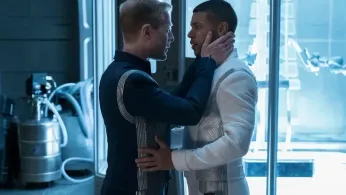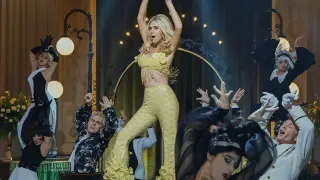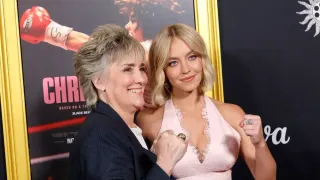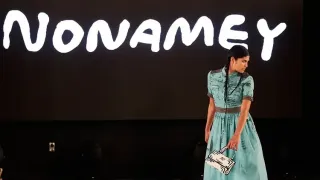
4 hours ago
Out Among the Stars: Why Queer Audiences Claim Sci-Fi as Their Own
READ TIME: 4 MIN.
If you’ve ever caught yourself swooning over a dashing alien, found your heart pounding at the slow-burn tension between two space explorers, or felt your soul resonate with the idea of a “chosen family” fighting against the odds, you’re not alone. For generations, LGBTQ+ audiences have gravitated toward science fiction, finding in its alternate universes both the freedom to exist and the promise of a future where queerness isn’t just tolerated—it’s celebrated. But what is it about sci-fi that makes it such fertile ground for queer dreams, identities, and narratives?
Let’s start with a history lesson that’s as much about survival as it is about stardust. For much of the 20th century, open queer representation on screen was taboo—often outright forbidden by Hollywood’s notorious Hays Code and its television successors. Yet, as with all things queer, where there’s a will, there’s a workaround. Sci-fi became a genre of winks, nods, and knowing glances: the double life of Superman, the dual identity of Spock, and the “outsider” status of Star Trek’s alien crew members all mirrored the experiences of queer people living in a world that didn’t want to see them. As Rotten Tomatoes notes, “Many queer fans, who were used to having to read into subtext, never thought the show would officially canonize Willow and Tara’s relationship” in Buffy the Vampire Slayer—a moment that, when it came, changed television history and lesbian representation forever .
But this isn’t just about finding crumbs. Fast-forward to today, and the doors of the starship airlock are wide open. Shows like "Star Trek: Discovery" bring us the quiet, revolutionary intimacy of Dr. Hugh Culber and Paul Stamets—two men brushing their teeth together, their love story as much a part of the universe as warp speed or tribbles. “It’s a tender beat of a kind that often gets overlooked in sci-fi,” as Rotten Tomatoes puts it. And when "Sense8", the globe-spanning, gender-bending Netflix series by the Wachowski Sisters, culminated in the joyful wedding of Nomi and Amanita—a trans woman and her beloved, atop the Eiffel Tower—queer fans everywhere saw the future they’d always imagined: “A raucous party, made even more effervescent not only by its queerness but by the fact that it centers on an interracial couple and a trans woman finding joy in the end” .
What makes these moments matter isn’t just visibility—it’s the radical reimagining of what love, family, and identity can be. "The Expanse," for example, doesn’t just give us queer characters; it gives us queer families, depicting polyamorous relationships as healthy, loving, and ordinary. Camina Drummer’s journey from fierce loner to cherished partner in a polyamorous family is powerful precisely because it’s so grounded: “The depiction of polyamory felt grounded, earnest, and open, as opposed to the more vilified or sexualized depictions featured elsewhere. It truly showcased in microcosm what made "The Expanse" so great” .
In these stories, the found family is everything. Whether you’re on the bridge of the Enterprise, the halls of Hogwarts, or the neon-lit streets of The Matrix, sci-fi and fantasy offer blueprints for kinship that aren’t bound by blood or biology. They echo the real-life networks of love and support that LGBTQ+ people build, often out of necessity. “Chosen family” isn’t just a trope—it’s survival strategy and celebration rolled into one.
Long before “explicit” was even an option, queer audiences became experts at decoding subtext. The British Film Institute highlights the resonance of characters like Jadzia Dax from "Star Trek: Deep Space Nine," who particularly struck a chord with transgender viewers for her fluid identity and relationships, or the tragic but radical lesbian love story embedded in V for Vendetta . We’ve been reading ourselves into the narrative for decades.
But the times, they are a-changing. Now, those subtexts are becoming texts. The “everyone is queer” energy of "Torchwood," with its pansexual hero Captain Jack Harkness, or the gender-expansive world-building of "The Sandman," where the Endless exist outside human notions of gender and sexuality, show that queer folks are no longer satisfied with mere hints. As Autostraddle notes, “There was a long time where I couldn’t figure out what the heck was going on re: the queerness of this aliens-among-us reboot of the 90s show, but eventually they made it crystal clear that alien hottie Isobel is bisexual as heck… you can in fact have multiple main queer couples at the same time” .
So, why does sci-fi still hold such powerful sway for queer audiences? Maybe it’s because the genre, at its best, is about imagining what could be—not just for society at large, but for ourselves. It’s a place where difference is a superpower, where outcasts save the world (and each other), and where the rules of gender, sexuality, and love are made to be rewritten. As Donald Glover, who played Lando Calrissian in "Solo: A Star Wars Story," mused in a Sirius interview: “How can you not be pansexual in space?” .
We flock to these stories for the same reason we throw rainbow confetti at Pride: to claim visibility, to imagine new worlds, and to find joy in being exactly who we are—whether that’s a starship captain, a vampire slayer, a nonbinary deity, or just someone who loves love in all its dazzling forms.
As sci-fi continues to push the boundaries of what’s possible, one thing’s for sure: wherever there are alternate universes, you’ll find us—queer, creative, and unafraid to write ourselves into the stars.






